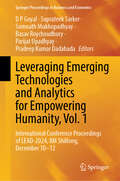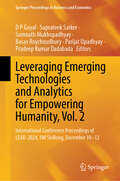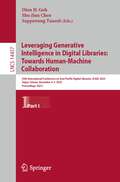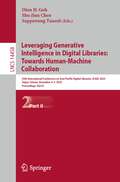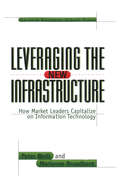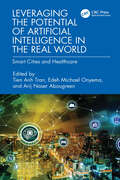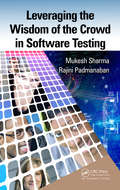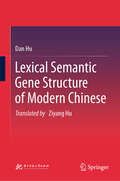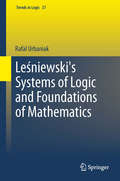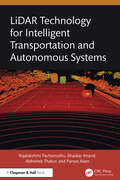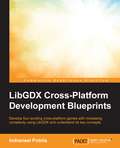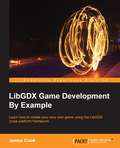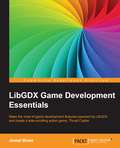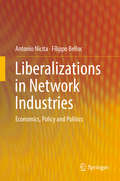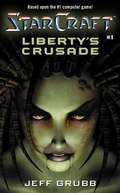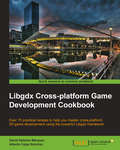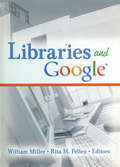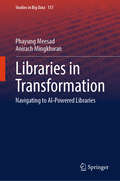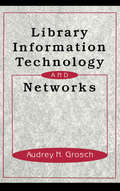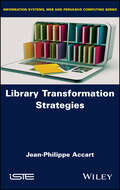- Table View
- List View
Leveraging Emerging Technologies and Analytics for Empowering Humanity, Vol. 1: International Conference Proceedings of LEAD-2024, IIM Shillong, December 10–12 (Springer Proceedings in Business and Economics)
by Somnath Mukhopadhyay Suprateek Sarker D P Goyal Basav Roychoudhury Parijat Upadhyay Pradeep Kumar DadabadaThis book provides a platform for interdisciplinary discussions on leveraging emerging technologies and analytics to empower humanity, fostering collaboration between experts in AI and analytics, sustainability, different areas of management, and IT. As the world grapples with complex challenges, from climate change to economic inequality, this first volume of a two-volume proceedings series is a crucial resource for fostering collaboration and exploring untapped potential of emerging technologies. By harnessing the power of AI, blockchain, IoT, and big data, the chapters address critical global challenges towards improving quality of life and promoting inclusive and sustainable development, while keeping in mind ethical implications, and their impact on social justice. The volume will be of use to thought leaders, researchers, innovators, and policymakers from around the globe who are interested in knowing more on how cutting-edge technologies can be harnessed for the greater good of society.
Leveraging Emerging Technologies and Analytics for Empowering Humanity, Vol. 2: International Conference Proceedings of LEAD-2024, IIM Shillong, December 10–12 (Springer Proceedings in Business and Economics)
by Somnath Mukhopadhyay Suprateek Sarker D P Goyal Basav Roychoudhury Parijat Upadhyay Pradeep Kumar DadabadaThis book provides a platform for interdisciplinary discussions on leveraging emerging technologies and analytics to empower humanity, fostering collaboration between experts in AI and analytics, sustainability, different areas of management, and IT. As the world grapples with complex challenges, from climate change to economic inequality, this second volume of a two-volume proceedings series is a crucial resource for fostering collaboration and exploring untapped potential of emerging technologies. By harnessing the power of AI, blockchain, IoT, and big data, the chapters address critical global challenges towards improving quality of life and promoting inclusive and sustainable development, while keeping in mind ethical implications, and their impact on social justice. The volume will be of use to thought leaders, researchers, innovators, and policymakers from around the globe who are interested in knowing more on how cutting-edge technologies can be harnessed for the greater good of society.
Leveraging Emotional and Artificial Intelligence for Organisational Performance
by Catherine PrenticeThis book takes a fresh stance and views EI and AI as services that are provided by service employees and machines as organisational offerings to customers. As emotional intelligence (EI) and artificial intelligence (AI) have been cited to have broad effects on individuals, businesses and beyond, this book is focused on the organisational context, specifically how they affect employees and customers from a marketing perspective. The stance in this book is consistent with the conceptualisation of a service. This book holds that intelligence in businesses must turn into organisational assets to manifest their values. Further, this book explores this service-dominant logic era, and compared to tangible products, service plays a key role in organisational performance and customer relationship with the organisation. Intelligence exhibited either by human or machine is not a tangible product, but can be utilised as a service to assist employees in performing tasks and delivering services as well as facilitating business transaction and customer experience.This book is structured as follows. Chapters 2 and 3 demystify emotional and artificial intelligence, from different perspectives, including conceptualisations, the history and evolution of the concepts, how they function and where they can apply to. These discussions help readers understand what exactly these two intelligences are. Chapters 4 and 5 analyse how emotional intelligence is related to employees and customers, respectively, with a focus on service organisations. Chapters 6–8 are dedicated to anatomising AI and how it is operationalised as a service to influence employees and customers. Specifically, viewing AI as a service, Chapter 6 examines the impact of AI service quality and how it is related to employee service quality. Chapter 7 analyses the influence of AI service quality on customers. Based on the discussion in Chapters 6 and 7, Chapter 8 is extended to develop a scale to measure such AI service, named AI service quality.The last three chapters of this book integrate EI and AI to analyse their respective impacts on employees and customers. Chapter 9 proposes EI as a moderator of AI, whereas Chapter 10 proposes AI as a moderator of EI. Chapter 11 employs service profit chain to integrate EI and AI in the chain relationship to understand their effects on both employees and customers. This chapter broadly covers the service industry with a focus on tourism and hospitality sector. The discussion on the impact of EI and AI is complemented with empirical studies conducted in tourism or hospitality context to address their effects in these sectors.
Leveraging Generative Intelligence in Digital Libraries: 25th International Conference on Asia-Pacific Digital Libraries, ICADL 2023, Taipei, Taiwan, December 4–7, 2023, Proceedings, Part I (Lecture Notes in Computer Science #14457)
by Dion H. Goh Shu-Jiun Chen Suppawong TuarobThis two-volume set LNCS 14457 and LNCS 14458 constitutes the refereed proceedings of the 25th International Conference on Asia-Pacific Digital Libraries, ICADL 2023, held in Taipei, Taiwan, during December 4-7, 2023. The 15 full, 17 short, 2 practice papers and 12 poster papers presented in this volume were carefully reviewed and selected from 85 submissions. Based on significant contributions, the full and short papers have been classified into the following topics: include information retrieval, knowledge extraction and discovery, cultural and scholarly data, information seeking and use, digital archives and data management, design and evaluation of information environments, and applications of GAI in digital libraries.
Leveraging Generative Intelligence in Digital Libraries: 25th International Conference on Asia-Pacific Digital Libraries, ICADL 2023, Taipei, Taiwan, December 4–7, 2023, Proceedings, Part II (Lecture Notes in Computer Science #14458)
by Dion H. Goh Shu-Jiun Chen Suppawong TuarobThis two-volume set LNCS 14457 and LNCS 14458 constitutes the refereed proceedings of the 25th International Conference on Asia-Pacific Digital Libraries, ICADL 2023, held in Taipei, Taiwan, during December 4-7, 2023. The 15 full, 17 short, 2 practice papers and 12 poster papers presented in this volume were carefully reviewed and selected from 85 submissions. Based on significant contributions, the full and short papers have been classified into the following topics: include information retrieval, knowledge extraction and discovery, cultural and scholarly data, information seeking and use, digital archives and data management, design and evaluation of information environments, and applications of GAI in digital libraries.
Leveraging the New Infrastructure
by Peter Weill Marianne BroadbentImagine thinking about your company's information technology in the same way that you think about its investment portfolio: as a bundle of assets that--when managed right--will generate revenues and savings. Here's just such a framework for leveraging IT (technology, networks, data, and software)--one that enables business managers to make the important decisions about the potentially confounding mix of high-technology that influences near- and long-term planning, affects the ability to support customers, and dictates the flow of daily operations. Drawing upon their rigorous research with more than 100 top multinationals, the authors present a rich and varied range of examples of IT investment strategies that have reaped rewards for firms such as Citibank, Honda, Johnson & Johnson, Ralston Purina, the Development Bank of Singapore, and Telstra. This hands-on resource, compete with benchmarks and case studies, creates the common ground where both management and IT can meet, communicate their goals, and agree on the best plan for getting there.
Leveraging the Potential of Artificial Intelligence in the Real World: Smart Cities and Healthcare (Advances in Digital Technologies for Smart Applications)
by Tien Anh Tran Edeh Michael Onyema Arij Naser AbougreenArtificial Intelligence (AI) is reshaping our urban landscapes and healthcare systems. From enhancing efficiency in smart cities to delivering personalized healthcare solutions, AI holds the key to a transformative future.Comprising seven insightful chapters, this book offers a comprehensive overview of key topics shaping the future of healthcare systems and smart cities. This book is a combination of the smart healthcare system and the intelligent transportation system based on AI. From telemedicine’s global accessibility to the application of data-mining techniques in predicting cardiac diseases and detecting anti-malaria drug resistance, each chapter presents cutting-edge research and practical applications.Furthermore, this book explores the integration of advanced AI technologies into healthcare systems, paving the way for cost-effective solutions and innovative approaches. It also delves into the challenges associated with analyzing electroencephalogram data and predicting anxiety and depression among elderly patients, offering promising solutions and insights.This book discusses the realms of smart cities and healthcare, where AI promises to revolutionize efficiency, sustainability, and personalized care delivery. Researchers/scholars and graduate students at universities/research institutes and research engineers in computer science, transportation, and engineering industries will find this book beneficial.
Leveraging the Wisdom of the Crowd in Software Testing
by Mukesh Sharma Rajini PadmanabanIts scale, flexibility, cost effectiveness, and fast turnaround are just a few reasons why crowdsourced testing has received so much attention lately. While there are a few online resources that explain what crowdsourced testing is all about, there's been a need for a book that covers best practices, case studies, and the future of this technique. Filling this need, Leveraging the Wisdom of the Crowd in Software Testing shows you how to leverage the wisdom of the crowd in your software testing process. Its comprehensive coverage includes the history of crowdsourcing and crowdsourced testing, implementation practices, and future trends. The book discusses best practices in implementation-explaining what, when, and how to crowdsource in a testing effort. It also includes case studies that illustrate how both product and service companies have successfully applied crowdsourcing in their testing programs. Explaining how to use the combined advantages of crowdsourcing and cloud computing for software testing, the book examines various engagement models in which you could implement crowdsourced testing. It addresses effective defect management in crowdsourced testing and considers both the business and engineering aspects of crowdsourced testing. The book explores the challenges, limitations, and situations when crowdsourced testing will not work and provides powerful best practices for mitigating the constraints and challenges, including how to build a crowdsourcing platform to test software products. Covering career opportunities for crowd testers, the book concludes by taking a look at the need to build a crowdsourced testing ecosystem, who the players of such an ecosystem would be, and who would need to champion such an effort.
Lexical Semantic Gene Structure of Modern Chinese
by Dan HuThis book draws on genetic theory to explore the microstructure of lexical meaning, the operating mechanism of the lexical semantic system and its formal representation, and methods for large-scale lexical computing resource construction. At the theoretical level, the basic framework of lexical semantic gene theory is proposed and elaborated. In this context, a lexical semantic gene is a basic structural unit of lexical meaning that controls a semantic feature of a word and can be inherited and recombined to construct a new word. Lexical meaning has multiple dimensions, and each dimension is regarded as a semantic feature composed of several lexical semantic genes according to certain semantic relations. The generation of new words is the result of the inheritance, reorganization, and mutation of lexical semantic genes. Drawing on this basis, the book subsequently explores the techniques of lexical semantic gene extraction and formalized description of lexical semantic genetic structure at the level of engineering technology. Bearing in mind the dual needs of formalized representation of semantic computation on the one hand and traditional language teaching, research, and lexicography on the other, the book employs language fact analysis to define strategies, methods, and operational procedures for a lexical semantic gene depiction meta-language system, lexical semantic genetic structure analysis, and lexical semantic gene extraction. At the application level, the computational and traditional applications of the lexical semantic gene database are discussed.
Leśniewski's Systems of Logic and Foundations of Mathematics
by Rafal UrbaniakThis meticulous critical assessment of the ground-breaking work of philosopher Stanislaw Leśniewski focuses exclusively on primary texts and explores the full range of output by one of the master logicians of the Lvov-Warsaw school. The author's nuanced survey eschews secondary commentary, analyzing Leśniewski's core philosophical views and evaluating the formulations that were to have such a profound influence on the evolution of mathematical logic. One of the undisputed leaders of the cohort of brilliant logicians that congregated in Poland in the early twentieth century, Leśniewski was a guide and mentor to a generation of celebrated analytical philosophers (Alfred Tarski was his PhD student). His primary achievement was a system of foundational mathematical logic intended as an alternative to the Principia Mathematica of Alfred North Whitehead and Bertrand Russell. Its three strands--'protothetic', 'ontology', and 'mereology', are detailed in discrete sections of this volume, alongside a wealth other chapters grouped to provide the fullest possible coverage of Leśniewski's academic output. With material on his early philosophical views, his contributions to set theory and his work on nominalism and higher-order quantification, this book offers a uniquely expansive critical commentary on one of analytical philosophy's great pioneers.
LiDAR Technology for Intelligent Transportation and Autonomous Systems
by Abhishek Thakur Rajalakshmi Pachamuthu Bhaskar Anand Parvez AlamThis book explores the critical role of LiDAR technology in autonomous navigation and advanced driver assistance systems (ADAS). It explores the fundamental principles of LiDAR, comparing it with other sensor technologies like radar and cameras while examining the various types of LiDAR systems, including time-of-flight, flash, and frequency-modulated continuous wave systems. It emphasises real-world use cases, including setting up LiDAR data acquisition systems and addressing challenges like sensor calibration, alignment, and integration into autonomous systems.• Discusses in detail LiDAR’s working principles, laser pulse wavelengths, point cloud data, motion compensation, and datasets commonly used in LiDAR research.• Examines the effects of ambient light, adverse weather conditions (rain, fog, snow), and practical strategies for mitigating these challenges.• Describes advanced methods for object detection, segmentation, and multi-object tracking using LiDAR point clouds, including solutions like AnchorPoint and Smart3DMOT.• Presents techniques for creating high-definition 3D maps and implementing SLAM (Simultaneous Localization and Mapping) that are essential for autonomous navigation.• Offers practical insights into autonomous navigation, including LiDAR-based localization, path planning, obstacle avoidance, and real-world case studies like autonomous shuttles.• Explores multi-LiDAR calibration, emphasizing alignment, fusion, and synchronization to enhance coverage and reduce blind spots in autonomous systems.· Offers a detailed guide on open-source LiDAR processing tools like PCL, Open3D, and ROS for data handling and visualization.By combining theoretical principles with practical applications and case studies, this book serves as a reference book for academics and researchers in computer science, electronics, communication engineering, and autonomous technologies.
Liability for Crimes Involving Artificial Intelligence Systems
by Gabriel HallevyThe book develops a general legal theory concerning the liability for offenses involving artificial intelligence systems. The involvement of the artificial intelligence systems in these offenses may be as perpetrators, accomplices or mere instruments. The general legal theory proposed in this book is based on the current criminal law in most modern legal systems. In most modern countries, unmanned vehicles, sophisticated surgical systems, industrial computing systems, trading algorithms and other artificial intelligence systems are commonly used for both industrial and personal purposes. The question of legal liability arises when something goes wrong, e. g. the unmanned vehicle is involved in a car accident, the surgical system is involved in a surgical error or the trading algorithm is involved in fraud, etc. Who is to be held liable for these offenses: the manufacturer, the programmer, the user, or, perhaps, the artificial intelligence system itself? The concept of liability for crimes involving artificial intelligence systems has not yet been widely researched. Advanced technologies are forcing society to face new challenges, both technical and legal. The idea of liability in the specific context of artificial intelligence systems is one such challenge that should be thoroughly explored.
LibGDX Cross-Platform Development Blueprints
by Indraneel PotnisDevelop four exciting, cross-platform games using LibGDX with increasing complexity and understand its key concepts About This Book * Learn how to make a complete game from scratch using the LibGDX framework * Discover different aspects of game development, optimize them, and implement them in your games * This is a comprehensive guide packed with concepts that are covered in an incremental manner Who This Book Is For If you have a good grip of Java and want to explore its capabilities in game development, this book is for you. Basic knowledge of LibGDX is preferred, but is not mandatory. What You Will Learn * Set up the development environment and implement a very simple game type * Implement new features such as motion, sounds, and randomness by implementing a new game * Add music, physics, and menus to your games * Start the creation of a platformer game and apply optimisation techniques * Perform collision detection and manage the game assets * Render game levels designed in the tool and add enemies * Create multiple levels, enemy motion, and level transitions in the game In Detail LibGDX is a very popular open source game framework for the Java programming language. It features deployment to multiple platforms with the same code base and it is very fast. Its vast amount of features makes it very easy to learn and master game development without knowing the low-level details. LibGDX Cross-platform Development Blueprints teaches you the concepts of game development using the LibGDX framework as you make four complete games. You'll start with setting up the environment, then move on to advanced concepts such as collision detection, memory optimization, and more. The first game is Monty Hall, where you'll learn how to set up LibGDX and use simple graphics. Then, you'll get to know more about concepts such as animation, game sounds, and scoring by developing a Whack a Mole game. This will set up the base for a Bounce the Ball game, where you'll get to grips with advanced concepts such as movements and collisions based on physics. Finally, the Dungeon Bob game will help you understand player motion. This guide gives you everything you need to master game development with LibGDX. Style and approach This is an easy-to-understand guide, packed with examples and illustrations along the way. Complex areas are broken down into bite-size chunks and are explained in detail. The difficulty levels of games are built throughout the chapters.
LibGDX Game Development By Example
by James CookLearn how to create your very own game using the libGDX cross-platform framework About This Book * Learn the core features of libGDX to develop your own exciting games * Explore game development concepts through example projects * Target games for major app stores quickly and easily with libGDX's cross-platform functionality Who This Book Is For This book is intended for those who wish to learn the concepts of game development using libGDX. An understanding of Java and other programming languages would definitely be helpful, although it is not a must. What You Will Learn * Create and configure a libGDX project to get started with making games * Get to grips with a simple game loop that will drive your games * Manage game assets to reduce code duplication and speed up development * Pack game assets together into single assets to increase your game's performance * Display textures on the screen and manipulate them with play input * Play various types of sounds that a game can generate * Design and modify a game user interface with libGDX's built-in tools * Develop a game that will run across various platforms In Detail LibGDX is a cross-platform game development framework in Java that makes game programming easier and fun to do. It currently supports Windows, Linux, Mac OS X, Android, and HTML5. With a vast feature set on offer, there isn't a game that can't be made using libGDX. It allows you to write your code once and deploy it to multiple platforms without modification. With cross-platform delivery at its heart, a game can be made to target the major markets quickly and cost effectively. This book starts with a simple game through which the game update cycle is explained, including loading textures onto your screen, moving them around, and responding to input. From there you'll move on to more advanced concepts such as creating a formal game structure with a menu screen, adding a game screen and loading screen, sprite sheets, and animations. You'll explore how to introduce a font to optimize text, and with the help of a game that you'll create, you'll familiarise yourself with the 2D tile map API to create worlds that scroll as the characters move. In the final sample game of the book, you'll implement a basic version of an Angry Birds clone, which will allow you to use the physic library box2D that libGDX provides access to. An overview of exporting games to different platforms is then provided. Finally, you will discover how to integrate third-party services into games and take a sneak peak at the Social Media API to get a basic understanding of how it fits into the libGDX ecosystem. Style and approach With this book you'll learn game development with libGDX through example game projects. You'll finish the book with a thorough understanding of libGDX game development, along with completed games that you'll have built yourself.
LibGDX Game Development Essentials
by Juwal BoseIf you are a Java developer who wants to learn LibGDX and create great games, then this book is for you. To take full advantage of this book, you are expected to be familiar with Java or any other object-oriented language. Experience of using Eclipse will be very useful.
Liberalizations in Network Industries
by Antonio Nicita Filippo BellocThis book explores the wave of liberalization reforms experienced by OECD network industries. Focusing on the telecommunications sector, the authors analyze the latest data available on liberalization and privatization, and following a political economics approach, they integrate standard economic analysis with the most recent studies of the political determinants of market-oriented policies. The book presents new econometric evidence on several policy issues, including institutional complementarities dynamics, the problem of policy sequencing and the role of government political ideology. The detailed and comprehensive discussion offers insights into how so many countries adopting similar reforms actually differ in their policy bundling, intensity and implementation of liberalization and privatization. "
Liberty's Crusade
by Jeff GrubbFar in the future, 60,000 light-years from Earth, a loose confederacy of Terran exiles is locked in battle with the enigmatic Protoss and the ruthless Zerg Swarm. Each species struggles to ensure its own survival among the stars in a war that will herald the beginning of mankind's greatest chapter -- or foretell its violent, bloody end. Danny Liberty was a good reporter...too good. When his investigations struck too close to the heart of the corrupt Terran Confederacy, he faced a simple choice: continue his current series of exposés, or take a hazardous new assignment covering the Marines on the front lines of the Koprulu Sector. It didn't take him long to decide.... Behind the attacks of the Zerg and the Protoss lies the story of a lifetime, but every piece of information blurs the mystery further. Thrown into the middle of a war where the outcome will determine mankind's very survival, the only thing that Danny Liberty knows for sure is that the only person he can trust to keep him alive is himself. Liberty's Crusade The first in an epic new series of space warfare novels set in the world of the bestselling computer game!
Libgdx Cross-platform Game Development Cookbook
by Alberto Cejas Sanchez David Saltares MarquezIf you want to make cross-platform games without the hassle and dangers of writing platform-specific code, or If you are a game programmer who may have some experience with Java and you want to learn everything you need to know about Libgdx to produce awesome work, this is the book for you. To take full advantage of the recipes in this book, you are expected to be familiar with java with good game programming knowledge.
Liblouis User's and Programmer's Manual
by AbilitiessoftA guide for users and programmers on Liblouis, an open-source braille translator and back-translator.
Liblouisxml User's and Programmer's Manual
by Abilitiessoft Viewplus TechnologiesA user's and programmer's guide for Liblouisxml, a software component for translating XML into braille.
Libraries and Google: New Google Applications And Tools For Libraries And Library Users
by William Miller Rita M. PellenDiscover the benefits-and drawbacks-of Google® Google® has become a nearly omnipresent tool of the Internet, with its potential only now beginning to be realized. How can librarians effectively integrate this powerful search engine to provide service to their patrons? Libraries and Google® presents leading authorities discussing the many possibilities of using Google® products as effective, user-friendly tools in libraries. Google Scholar and Print are extensively explored with an eye toward offering an expanded view of what is and may be possible for the future, with practical insights on how to make the most of the product&’s capabilities.It seems certain that Google® is here to stay. Libraries and Google® comprehensively examines this "disruptive technology" that is seen as both a threat and an opportunity by both librarians and publishers. Both perspectives are explored in depth, along with practical applications of this and other Google® technology that may be new to librarians. Google® products and other more familiar research tools are compared for effectiveness and ease of use. The various unique needs of users and scholars are detailed and considered as a springboard for insightful discussion of the future role of librarians in today&’s world. Potential problems are closely examined, such as copyright issues of digitization, and privacy concerns sparked by its collection of personal information about its users. The book comprehensively explores the path libraries need to travel to benefit from the search tool, rather than being overwhelmed and destroyed by it.Topics in Libraries and Google® include: the viewpoint that Google® may make libraries obsolete new opportunities for libraries through using Google® products technical aspects of purchasing and implementing Google® search products with proprietary vendor databases testing the performance of Google Scholar and Print practical use of Google®&’s products personal privacy issues making digitized library resources more accessible digitization of copyrighted materials much, much more!Libraries and Google® is horizon-expanding reading for all librarians, library science educators and students, library administrators, publishers, and university presses.Volume 2 of Libraries and Google® is in preparation.Google® is a Registered Service Mark of Google, Inc., Mountain View, California. Libraries and Google® is an independent publication offered by The Haworth Press, Inc., Binghamton, New York, and is not affiliated with, nor has it been authorized, sponsored, endorsed, licensed, or otherwise approved by, Google, Inc.
Libraries in Transformation: Navigating to AI-Powered Libraries (Studies in Big Data #157)
by Phayung Meesad Anirach MingkhwanThis book discovers how libraries evolved in the digital age with “Libraries in Transformation: Navigating to AI-powered Libraries.” This insightful book explores the profound shifts within libraries due to the integration of advanced technologies such as artificial intelligence (AI) and the Internet of Things (IoT). Providing a comprehensive roadmap, this book guides libraries in adapting and thriving while maintaining their core mission of providing universal access to knowledge and fostering community engagement.
Library Information Technology and Networks
by Charles GroschOffers an historical perspective of the past 25 years of computers in libraries, profileing currently available processing systems according to their size and platform. The short- and long-term future of information technology in libraries.;College or university bookstores may order five or more copies at a special student price which is available from Marcel Dekker upon request.
Library Outreach, Partnerships, and Distance Education: Reference Librarians at the Gateway
by Pixey Anne Mosley Wendy ArentIncrease patronage with effective outreach strategies!From the Introduction, by Wendi Arant and Pixie Anne Mosley: “Outreach is a concept that is gaining more and more significance for libraries, particularly with the recent developments in information technology. Dictionaries define it as 'the act of extending services, benefits, etc. to a wider section of the population.’This definition also implies a mission to communicate a particular message to an audience in order to gain their support. Its meaning for libraries is profound, having consequences for fund raising, public service, and public relations.”Library Outreach, Partnerships, and Distance Education: Reference Librarians at the Gateway focuses on extending community outreach in libraries toward a broader public by expanding services that are based on recent advances in information technology. This crucial volume with help you will explore many of the issues that are currently affecting libraries, including: the growth of technology and its effect on libraries and library users emerging literacy issues (computer literacy, non-English-speaking populations) providing effective services to at-risk populations diversity and multiculturalism and how they are changing the ways that libraries are used targeting and reaching specific user groups distance education--bringing the mountain to MohammedIf the public perception of libraries is ever to move beyond that of “musty old book warehouses,” librarians must take a more active role in the development of new services and in heightening awareness of their existing services and collections. Library Outreach, Partnerships, and Distance Education presents ideas and strategies that are now being implemented around the United States to do just that. This book should be a part of every library's plans for the future!
Library Transformation Strategies
by Jean-Philippe AccartLibraries continually focus on adaptation and adopt different transformation strategies to achieve this goal. These strategies demonstrate a clear desire to stay in tune with the times, while retaining the basic principles that underpin their day-to-day work and ensure they continue to exist. This book is a complete synthesis, a helpful resource for librarians and information professionals that develops four major strategies. The first focuses on understanding the environment and society, with organizational changes affecting cultural institutions (public or private), and the emergence of the library space. The second shows how management methods evolve within them (participatory approach, benevolence, empathy) with an emphasis on project management. The third strategy focuses on the integration of new library tools to better reach audiences. Finally, the fourth develops an essential and indispensable aspect of library marketing. This book is a complete synthesis, a helpful resource for librarians and information professionals that develops four major strategies. The first focuses on understanding the environment and society, with organizational changes affecting cultural institutions (public or private), and the emergence of the library space. The second shows how management methods evolve within them (participatory approach, benevolence, empathy) with an emphasis on project management. The third strategy focuses on the integration of new library tools to better reach audiences. Finally, the fourth develops an essential and indispensable aspect of library marketing.Libraries continually focus on adaptation and adopt different transformation strategies to achieve this goal. These strategies demonstrate a clear desire to stay in tune with the times, while retaining the basic principles that underpin their day-to-day work and ensure they continue to exist. This book is a complete synthesis, a helpful resource for librarians and information professionals that develops four major strategies. The first focuses on understanding the environment and society, with organizational changes affecting cultural institutions (public or private), and the emergence of the library space. The second shows how management methods evolve within them (participatory approach, benevolence, empathy) with an emphasis on project management. The third strategy focuses on the integration of new library tools to better reach audiences. Finally, the fourth develops an essential and indispensable aspect of library marketing. Jean-
